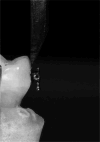Comparative analysis of shear bond strength and debonding characteristics of bioactive versus conventional orthodontic adhesives: An in-vitro study
- PMID: 40397265
- PMCID: PMC12133651
- DOI: 10.1007/s44445-025-00002-5
Comparative analysis of shear bond strength and debonding characteristics of bioactive versus conventional orthodontic adhesives: An in-vitro study
Abstract
Adhesives are essential for attaching orthodontic brackets to the tooth surface and ensuring safe removal during debonding. ACTIVA™ BioACTIVE-Restorative (ABR) is a bioactive composite with potential advantages. The purpose of this study was to evaluate the shear bond strength (SBS) and adhesive remnant index (ARI) of ACTIVA™ BioACTIVE-Restorative (ABR) with conventional adhesives, including Transbond XT™ (TXT) and Orthocem™ (OC). A total of 51 human maxillary premolars were distributed randomly into three groups (n = 17). Each group was bonded with one adhesive following the manufacturer's protocols. Then were subjected to 5000 thermocycles to simulate oral conditions. SBS was measured using a universal testing machine, and ARI scores were visually analysed under magnification. Statistical analysis was conducted using one-way ANOVA and chi-squared tests, with a 0.05 level of significance. Mean SBS values were 11.26 MPa, 12.52 MPa, and 12.96 MPa for ABR, TXT, and OC, respectively, with no significant differences (p = 0.513). ARI analysis revealed significant differences (p = 0.009) as ABR predominantly exhibited ARI 3 scores, indicating no adhesive remnants on enamel. In contrast, TXT and OC groups showed higher adhesive retention. ABR demonstrated shear bond strength comparable to conventional adhesives, meeting the clinical thresholds for orthodontic use. But demonstrated more complete adhesive failure in the enamel-adhesive interface rather than cohesive failure within the adhesive material like in TXT and OC.
Keywords: Adhesive Remnant Index (ARI); Bioactive materials; Debonding characteristics; Orthodontic adhesives; Shear bond strength.
© 2025. The Author(s).
Conflict of interest statement
Declarations. Ethical compliance: Ethical approval was granted by Taibah University College of Dentistry Research Ethics Committee. The study registration number is TUCDREC/030424/KBukhari. All procedures performed in studies were in accordance with the ethical standards of the institutional research committee and with the 1964 Helsinki Declaration and its later amendments. Conflict of interest: The authors declare that there was no conflict of interest on publication date.
Figures



Similar articles
-
A comparison of shear bond strength of orthodontic brackets bonded with four different orthodontic adhesives.J Orthod Sci. 2014 Apr;3(2):29-33. doi: 10.4103/2278-0203.132892. J Orthod Sci. 2014. PMID: 24987660 Free PMC article.
-
Shear Bond Strength and Bonding Properties of Orthodontic and nano Adhesives: A Comparative In-Vitro Study.Contemp Clin Dent. 2019 Oct-Dec;10(4):600-604. doi: 10.4103/ccd.ccd_842_18. Contemp Clin Dent. 2019. PMID: 32792817 Free PMC article.
-
The effect of repeated bonding on the shear bond strength of different orthodontic adhesives.Am J Orthod Dentofacial Orthop. 2002 May;121(5):521-5. doi: 10.1067/mod.2002.123042. Am J Orthod Dentofacial Orthop. 2002. PMID: 12045771
-
Comparative evaluation and influence of new Optibond eXTRa self-etch Universal adhesive and conventional Transbond XT on shear bond strength of orthodontic brackets-An in vitro study.J Orthod Sci. 2022 Aug 24;11:43. doi: 10.4103/jos.jos_22_22. eCollection 2022. J Orthod Sci. 2022. PMID: 36188208 Free PMC article.
-
Evaluation of the shear bond strength and adhesive remnant index of color change, fluorescent, and conventional orthodontic adhesives: An in vitro study.Int Orthod. 2023 Mar;21(1):100712. doi: 10.1016/j.ortho.2022.100712. Epub 2022 Dec 6. Int Orthod. 2023. PMID: 36493626
References
-
- Abd El Halim S (2018) Comparative evaluation of shear bond strength of a bioactive composite and nano-composite: an in vitro study. Egypt Dental J 64(2):1653–9
-
- Ali NAM, Nissan LM, Khamis AH, Al-Taai N (2024) Enamel demineralization around orthodontic brackets bonded with new bioactive composite (in-vitro study). J Baghdad Coll Dent 36(2):54–62
-
- Amin F, Fareed MA, Zafar MS, Khurshid Z, Palma PJ, Kumar N (2022) Degradation and stabilization of resin-dentine interfaces in polymeric dental adhesives: an updated review. Coatings 12(8):1094
LinkOut - more resources
Full Text Sources
